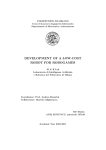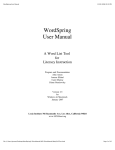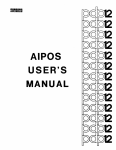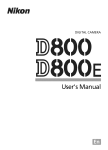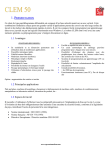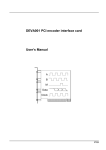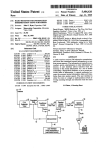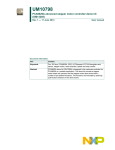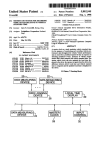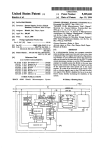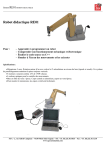Download System and a method for obtaining a mask programmable device
Transcript
US005717928A United States Patent [191 [11] Patent Number: [45] Date of Patent: Campmas et a]. 5,717,928 Feb. 10, 1998 “A VLSI Design Veri?cation Strategy". Aharon Tran et a1; IBM Research and Development vol. 26. No. 4, Jul. 1982, p. 475-484. [54] SYSTEM AND A METHOD FOR OBTAINING A MASK PROGRAMMABLE DEVICE USING A IJOGIC DESCRIPTION AND A FIELD PROGRAMMABLE DEVICE IMPLEMENTING THE LOGIC DESCRIPTION “The Weighted Random Test-Pattern Generato ”, Daniel Schmurmann et al, IEEE transaction of computer, vol. c-24. No. 7; Jul. 1975. pp. 695-700. [75] Inventors: Michel J. Campmas. Palo Alto; William A. Johnston. San Jose; Gai-Bing Chen. Cupertino, all of Calif. Dan Powers, “FGPA to Gate Array Migration: The Best of Both Worlds,” May 1990. pp. 345-348, Electro Conference Record, vol. 15. No. 9-11. [73] Assignee: Matra Hachette SA. Paris, France Primary Examiner-Meng-Ai T. An Attorney Agent, or Fimr-Skjerven. Merrill. MacPherson, [21] Appl. No.: 610,479 [22] Filed: Nov. 7, 1990 [51] Franklin & Friel; Edward C. Kwok [57} Int. Cl.‘5 .................................................... .. G06F 15/60 [52] U.S. Cl. 395/701; 395/500; 395/185.06; In accordance with the present invention. a system and 395/ 183.13 [58] Field of Search method for converting an implementation of a logic descrip tion describing a ?eld programmable device into an imple 395/500. 600. 39500053641578, 488, 451. 452 [56] mentation of the same logic in a factory-programmed device are provided. In one embodiment of the present invention. an expert system synthesizes a logic circuit model based on References Cited U.S. PATENT DOCUTVIENTS 4,590,581 5/1986 4,829,427 5/1989 4,901,259 2/1990 4,967,386 10/1990 Widdoes, Jr. Green Watkins Maeda et a]. 5,051,938 9/1991 Hyduke 364/578 2/1992 Chang et al. 4/1993 Goldberg et a1. 395/600 395/600 5,202,889 5,258,919 the logic description. An automatic test pattern generator provides test vectors including expected response signals for the logic circuit model generated by the expert system. The 364/578 395/600 364/578 364/578 5,089,985 5,201,046 ABSTRACT automatically generated test vectors are provided to a tester which applies the test vectors as input stimuli to the ?eld programmable device. The output signals of the ?eld pro grammable device are veri?ed against the expected response signals. If the output signals of the ?eld programmable 4/1993 Aharon et a1. ........ .. 371/27 11/1993 Yamanouchi et al. ................ .. 364/489 device match the expected response signals, the computer model is considered correct. and mask layout may begin for the building a mask-programmable circuit which performs the functions described in the logic description. OTI-IBR PUBLICATIONS “Dynamic process for generation of biased pseudo-random test patterns for the functional veri?caiton of hardware 8 Claims, 8 Drawing Sheets designs”; Aharon et :11, Apr. 1990 (Isarael). LAYOUT GENERATION i POST-LAYOUT Sll/IKAATON TIMING I. LOGIC US. Patent Feb. 10, 1998 Sheet 1 of 3 5,717,928 LOGIC EQUATIONS SCH EMATIC CAPTURE, NET LIST GENERATION "L101 I SIMULATION: TIMING & LOGIC @102 VERIFICATION LAYOUT FIG 1 GENERATION “103 I AT PSIIIIJIAYSIIT TIMING & LOGIC “104 VERIFICATION US. Patent Feb. 10, 1998 Sheet 5 of 8 5,717,928 .GEmm mm.wE ._. _ _ _ '_ _ _ _ _ _ _ _ n m8.8%. "an: _ I a _ _ x<> on:E3_$2_5 _ _ 1Ji‘tkI! US. Patent Feb. 10, 1998 INPUT_ IN Sheet 6 of 8 : 5,717,928 _OUTPUT INN FIG. 4 INPUT INPUT A B ——_U_ -— 0UTPUT OUT INPUT c —:D_ INPUT D —‘ FIG. 5 INPUT D INPUT CK D Q OUTPUT 0 >CK QN O———OUTPUT QN FIG. 6 INPUT A INPUTB ol?mm INPUT 0 INPUTE OUTPUT >o— EN FIG. 7 US. Patent Feb. 10, 1998 INPUTA INPUT B — INPUTC — Sheet 7 of 8 5,717,928 OUTPUT OUT “I FIG. 8 INPUT A INPUT B INPUT C INPUT E I? I OUTPUT NOR OUTPUT EN FIG. 9 INPUT A INPUT B INPUTE OUTPUT NOFI OUTPUT OR III I OUTPUT EN FIG. 10 INPUT A — I OUTPUT AN OUTPUT INPUT B ——>0— BN US. Patent Feb. 10, 1998 Sheet 8 of 8 5,717,928 OUTPUT NAN 'NPUT A _‘ OUTPUT INPUT B — AND OUTPUT INPUT E —1>0‘ EN FIG. 12 INPUT A D INPUT B INPUT 0 D N INPUT 0 FIG. 13 OUTPUT OUT 5,717,928 1 2 SYSTEM AND A METHOD FOR OBTAINING A MASK PROGRAMMABLE DEVICE USING A LOGIC DESCRIPTION AND A FIELD PROGRAMMABLE DEVICE IMPLEMENTING THE DOGIC DESCRIPTION model shown in FIG. 1, is not always straight forward. For FIELD OF THE INVENTION This invention relates to the ?eld of integrated circuits. In particular, this invention relates to the ?eld of programmable example, it is common for a schematic representation to be corrected and resimulated multiple times before arriving at an acceptable ?nal representation. At this point. as illustrated by decision point 110, the customer typically provides a "sign-off” to the ASIC vendor. indicating permission to go ahead to the next step 103, during which the layout of the customized mask is generated (“layout generation”). The 10 logic devices. Layout generation step 103 requires taking the netlist of the schematic representation to create patterns of geometric shapes on the customized “mask" layers. The customized BACKGROUND OF THE INVH‘ITION Field programmable logic devices. also commonly known masks created from these patterns are used in some of the as programmable logic devices (PLDs), are programmable photolithographic steps in the circuit fabrication process. These masks are generated according to the design rules of the ASIC vendor’s fabrication process and circuit technol integ'ated circuits sold to the user unprogrammed. The user then programs the device to provide logic functions required by his/her application. Examples of PLDs are discussed in the “PAL Device Data Book.” third edition (1988), pub lished by Advanced Micro Devices. Inc. of Sunnyvale, Calif. incorporated herein by reference in its entirety. (PALs ogy. The layout generation step 103 is also typically achieved using a variety of design software programs and 20 (component) libraries. The layout generated by step 103. is provided to a commercially available programming equipment, PLDs pro simulation and veri?cation program at step 104 to ensure vide design ?exibility and quick tum-around, which are important advantages for certain applications. For example. in the development of a product prototype, debugging in the ?eld environment can be accomplished by simply replacing that logic functions and timing parameters are accurately preserved during the translation from the netlist representa tion to the layout representation. These simulation and veri?cation programs may be the same as those used in step 30 opment is stabilized. A gate array circuit is a popular factory-programmed substitute for a PLD. A gate array circuit is typically 40 pattern of interconnect metallization, to interconnect the underlying generic array of transistors. The pattern of inter tion and veri?cation steps (103 and 104) are often necessary. After the customer is satis?ed with the layout generated. another “sign-01f," represented in FIG. 1 as decision step 120, is provided to the ASIC vendor to indicate permission to begin manufacturing the device. Again. the customer bases his/her decision upon careful perusal of the simulation and veri?cation results. The generated layout of step 104 is then used to build phowlithographic masks, which are used to manufacture the connect metallization is provided using customized photo gate array (step 106). masks. The gate an'ay circuit emerging from the fabrication process implements application-speci?c logic functions. 102 discussed above. At this point, many parameters speci?c to the physical implementation of the circuit, such as timing, may be more accurately estimated Once again. the layout generation process is not always straight forward. Several iterations of the layout generation and post-layout simula compatible factory-programmed device, after product devel programmed by providing during fabrication a customized databases. Some examples of these software programs and databases are place and route programs and “cell” and FPLAs are types of PLDs.) Because a PLD can be conveniently programmed using a faulty PLD by one implementing the correct logic. However. because each PLD must be individually programmed, PLDs are more expensive than factory programmed devices, which are mask programmed in large batches during the fabrication process without additional cost. It is therefore cost eifective, when a product is in high volume production, to replace a PLD with a pin-for-pin customer bases his/her go-ahead decision upon careful perusal of the simulation and veri?cation results. 45 As can be readily seen, to achieve the conversion from a Presently. the conversion from a PLD circuit to a factory PLD implementation to a factory-programmed circuit programmed circuit involves close cooperation between the supplier of the factory-programmed circuit (hereinafter, the implementation, expensive engineering time is often “ASIC vendor”) and the user of the PLD (hereinafter, the “customer”). FIG. 1 shows the steps required to accomplish the conversion. Referring to FIG. 1, the customer provides to the ASIC vendor at step 100 the logic description implemented in the PLD. As illustrated by step 101, this logic description is then 50 expended by the customer. Throughput time of the conver sion process is also prolonged by the time necessary for the customer to verify that the simulation results are acceptable. Such engineering and veri?cation costs add to the cost and time required to build the ?nal device. Hence, it is highly desirable to have an automated mechanism by which the customer's involvement, i.e. expensive engineering time as translated into a schematic representation of a logic circuit. 55 Well as simulation veri?cation, is minimized if not elimi nated. This step is often accomplished using a software schematic capture program. From this schematic representation, a SUMMARY OF THE INVENTION netlist is generated for use with simulators and veri?ers at step 102. These simulators and veri?ers are software pro In accordance with the present invention, a system and a grams which simulate the operation of the circuit repre method for converting a PLD device to a factory sented by the netlist to ensure that the intended logic programmed circuit are provided, wherein a logic descrip functions are correctly provided. Often at this step, propa tion of a PLD is used to generate a netlist. This netlist, in gation delays exhibited by the logic circuit represented by turn, is used to generate a test program. including test the netlist are estimated to determine if timing perforrnanoe vectors, for testing the PLD. The test program is then used targets are met. to test a PLD provided by the customer. and if the PLD The process of generating an acceptable schematic rep successfully passes the test, it is known that the netlist resentation from logic descriptions as illustrated by the accurately describes the PLD. Thus, the netlist can be used 5,717,928 3 4 to construct masks, and it is not necessary to involve the customer in simulation veri?cation. If the customer’s logic description is not in the ABEL format, an optional conversion program can be provided, such as shown in block 201 of FIG. 2. For example, in one The present invention is better understood in light of the embodiment, a program TOABEL (represented by block 201) translates PALASM format equations obtained from a following detailed description and accompanying drawings. ?le having ?le name extension .PAL to ABEL format and BRIEF DESCRIPTION OF THE DRAWINGS place the output ABEL logic equations in a ?le having ?le FIG. 1 illustrates the steps necessary to achieve a con version from a PLD device to a factory-programmed device name extension .ABL. (PALASM is well known in the 311. and is described in “PAL Device Data Book.” incorporated in the prior art. FIG. 2 is a block diagram showing a ?rst embodiment of herein by reference in its entirety above.) The progam TOABEL is well known in the art. and is available also from DATA I/O Corporation. mentioned above. TOABEL runs on IBM PC machines and Sun workstations. a system for converting a PLD device to a factory programmed device in accordance with the present inven tion. Block 202 shows the .ABL ?le (Le. ABEL ?le) being FIG. 3 is a block diagram showing a second embodiment 15 provided to an expert system known as GASP for generating a netlist of a logic circuit. A script or command ?le ABEL___ of a system for converting a PLD device to a factory TO_I-HLO is used to execute the various components of programmed device in accordance with the present inven GASP. GASP, also called GASP-LUCAS. is a rule-based tion. FIGS. 4. 5. 6. 7, 8. 9, 10, ll, 12 and 13 schematically illusn'ate logic devices used in an example of a program mable logic device being converted to a mask expert system available from Genrad Limited. Fareham, 20 programmable device. DETAILED DESCRIPTION 25 In accordance with the present invention. a system and a method of designing a factory-programmed circuit to UK. The GASP program takes as input ?les: 1) a ?le .ABL containing the logic description in the ABEL format (Appendix A1)‘, 2) a ?le .MPL which models the PLD device type (Appendix A2); 3) a “methods h‘brary ?le” .MET (Appendix A.3), which desrn'ibes how logic devices are constructed in the ASIC vendor’s circuit technology; 4) a MD.CEL library (Appendix AA) which lists logic func tions that are available in the ASIC vendor’s circuit tech replace a PLD are provided, using the logic description of nology; and 5) a rule base ?le .RCP, compiled from a set of the PLD circuit and a functioning PLD device. FIG. 2 is a block diagram of a ?rst embodiment of the system in accordance with the present invention. In accor dance with the present invention, the customer needs only .BAS ?les (Appendix A.5). which describe for GASP rules for e?iciently converting the logic description into a netlist describing interconnected logic cells of the types listed in the MD.CEL library. In response to these input ?les, GASP provides therefrom a netlist of a logic circuit which performs provide the ASIC vendor with a logic description and a functioning PLD device in which the logic desa'iption is implemented. With substantially no further involvement by 35 the customer, the ASIC vendor provides the customer a factory-programmed circuit suitable for mass production, and which is pin-for-pin compatible with the PLD device. circuit components, for example, the gates, buffers and ?ip-?ops in a circuit. The netlist identi?es the input and output leads of each circuit component and its connections to other circuit components. As mentioned above, the .MPL ?le models the generic PLD type. For example, to model an AMD 22Vl0, one would provide a ?le such as provided in Appendix A.2 In the embodiment shown in FIG. 2, block nos. 201 to 108, 211 to 213 and 216 represent execution of programs on data input ?les (described below). These programs can be executed on an IBM Personal Computer or a machine compatible with an IBM Personal Computer (hereinafter, “IBM PC”), or a Sun Microsystems Model Sun-3 worksta tion (hereinafter, “Sun-3”). However, other computers or the functions described in the .ABL ?le. Information con cerning the operation and use of GASP can be obtained from GenRad Incorporated, Fareham, UK. As is known in the art, a “netlist” is a type of circuit description which lists all 45 workstations may also be used. As shown in FIG. 2, a method in accordance with our invention commences when the customer provides a logic attached hereto. If one were to use the present invention to convert a device implemented in a different PAL type into a mask programmable device, one would modify the .MPL ?le appropriately. description representing the logic functions implemented in Attached as Appendix A6 is a netlist ?le (the .NET ?le) which GASP prepares from the .ABL, .MPL, MD.CEL, a PLD. The logic description can be expressed in a logic equation description language such as ABEL. Details con cerning ABEL can be found in “ABEL 3.0", published by MET‘ and RC? ?les discussed above. In the .NET ?le of Appendix A.7, after the line which states “BEGIN” is the Data I/O Corporation, Redmond, Wash., incorporated herein listing describing the logic performed by the circuit. The ?rst by reference in its entirety. In otha embodiments, other logic description languages may be used. Also, in other embodiments, other methods are used to provide a logic tam on each line in the Hating is a label associated with the 55 logic gate being described, the second item (enclosed in parentheses) is the name or names of the output signal or description, such as truth tables, or schematic representa signals provided by the gate, the third item, after the “:=" tions of logic circuits. An example of an input ?le containing ABEL logic equations is included in Appendix A.1 attached hereto. These equations describe logic to be implemented in an AMD 22V10 logic array. available from Advanced Micro punctuation, is the type of logic device represented by the Devices, Inc. of Sunnyvale. Calif. However, in other embodiments. other logic equations are used, which describe PLDs other than the 22V10. line, and the fourth item is the name or names of the input signal or signals. Thus, for the device described in the ?rst line following “BEGIN”, the gate is labeled GNISPD, its output signal is N13PD, it is of device type BUFIN'I'I‘L (a 'I'I'L input buffer), which receives input signal PIN13. Table I below lists the device types and abbreviations used in the .NET ?le of Appendix A.6. 5,717,928 6 5 tern or fault simulator is used. The SYSTEM HlLO program runs on the Sun-3. TABLE I The HITEST program takes as inputs the .CCT netlist ?le described above, a .KDB ?le containing a “knowledge base” description used in test vector generation, and a .DWL ?le Device Type Symbol BUFIN'I'IL INVP 'I‘I‘L compatible input buffer. 'Iwo parallel inverters (see Figure 4). B03N4 'Il'istate output buffer with 24 mA output drive. Z-input NAND gate. 2 wide 2-2 input AND OR INVEKI‘ (see hereby incorporated by reference in its entirety, is obtainable Figure 5). from GenRad Fareham Limited. Fareharn. UK. The de?ni NANDZ AOI2W22 DFFRNI NANDIB containing parameters of input and output waveforms. The de?nition and use of the .KDB ?le is provided in the “HH'EST Test Generator Reference Manual”. which is D-Flip Flop (See Figure 6). tion and use of the .DWL ?le is described in the “HITESI' 3-input NAND Gate with an inverter DWL Reference Manual”. which is hereby incorporated by (see Figure 7). AOI2W2l reference in its entirety. is obtainable also from GenRad Fareham Limited. An example each of the .KDB and the 2 wide 2-1 input AND OR INVEKI‘ (see Figure 8). NORB 3 input NOR gate with an inverter (see Figure 10). .DWL ?les are attached hereto as Appendices A.8 and A9 respectively. The examples of the .KDB and DWL ?les are appropriate when converting a device implemented in an Two inverters (see Figure ll). AMD 22Vl0 to a gate array implementation. If one were to Figure 9). ORI2 INVZ ANDI2 2 input OR gate with an inverter (see 2 input AND gate with an inverter (see convert from other generic device types (eg a PALZORAlO, Figure 12). NAND3 3 input NAND gate. aiso available from AMD). one would have to modify the POR Power on reset. 0AI2W22 2 wide 2 input OR AND OR INVERI‘ (see .KDB and .DWL ?les appropriately. The above described input ?les allow the HITEST pro Figure 13). The library of logic devices used with GASP may contain other logic devices. However, the circuit speci?ed by the .ABL ?le of Appendix A.1 requires only devices listed in 25 block 204, to ensure proper fault coverage by the test Table 1. Additional logic devices are described in “GATELlB Macrocell and Macro Function libraries" pub lished by Matra Design Semiconductor, Inc.. of Santa Clara, Calif. in 1987. As can be seen. the .NET ?le includes a circuit element POR. used for a power on reset of output register ?ip ?ops in the output circuitry of the 22Vl0. For simulation purpose, POR can be modeled as a delay line. As implemented in this embodiment. POR is a circuit with a large capacitance. Part of the software represented by block 202 includes a conversion program which receives the .NET ?le and gen erates therefrom a ?le .CCT (Appendix A.7). As can be seen from a cursory examination of the .NET and CCI‘ ?les from 35 40 vectors. HITBSI‘ provides a log ?le. identi?ed by ?le name extension .LOG (Appendix A. 11), which summarizes any exception condition encountered during fault simulation and test vector generation. The LOG ?le is merely a user report, which is not used as an input ?le for any programs. Optionally, the HH’EST module may also receive a set of “seed” test vectors. e.g. generated by the customer. HITESI‘ learns from and builds upon these seed vectors to more rapidly generate a set of test vectors (which include the seed vectors) to test the customer-provided PLD. In one embodiment, the .CCI‘ and .TAB ?les are input to a program ARCIS (block 207), which estimates the propa gation delays of signals through a circuit having the logic elements described in the .CCI‘ ?le, when the stimulus signals provided in the .TAB ?le are applied to the circuit. The operation and use of ARCIS as discussed in “GATEAID Appendices A.6 and A.7. respectively, this conversion soft ware merely rearranges, in a manner readily apparent, the positions of the gate names, types, and signal names on each line. After the .CCI‘ ?le has been prepared, it is necessary to gram to provide an output ?le .TAB including a set of test vectors. This .TAB ?le (Appendix A10) is intended for use as stimuli in testing the logic circuit described in the CC!‘ ?le. Fault detection analysis is used at this step illustrated by 45 PLUS/PC 2.0 User’s Manual”, second edition (1988), pub lished by Man-a Design Semiconductor, hereby incorporated generate test vectors which can be used to test a sample PLD by reference in its entirety. provided by the customer. As is well known in the art, test vectors, which are often expressed in table form, are stimu lus input signals provided to a circuit and the expected Prior to running ARCIS, it is necessary to convert the .CCT and .TAB ?les into a format that ARCIS can accept. Thus, block 206 represents a conversion program that receives ?le .TAB and generates therefrom a tile SIM circuit output signals responding to the input signals. A program known as SYSTEM HILO (block 204) is used to generate test vectors from the netlist. SYSTEM HILO is available from Genrad, Limited of Fareham, UK. A test pattern generation module HlTEST and a fault simulator HIFAULT are separately purchased parts of SYS TEM I-HLO. The operation of the HITEST module is described in “SYSTEM l-IlLO HITEST-Plus Reference Manual”. which is hereby incorporated by reference in its entirety. obtainable from GenRad Incorporated, Fareham, UK. The HIFAULT fault simulator, which is described in (Appendix A12). As can be seen. the conversion program represented by block 206 deletes the expected output signals from ?le .TAB because ARCIS will recalculate these sig 55 nals. The conversion program also causes the columns of the .SIM ?le to be in an order dilferent from that in the .TAB ?le. 60 Further, as shown in Appendix A12. the SIM ?le includes the following cormnands to the ARCIS program. 1. $CYCLE1 is a multiplier (in this case, 1.0) for the times listed in the .SIM ?le. 2. $LOAD 56 indicates that 50 pF loads are present on pins 14 to 73. 3. VCC CLKO 100 describes the power input waveform necessary to correctly simulate the POR function. the “HIFAULT Reference Manual”, hereby incorporated by reference in its entirety, is also obtainable from Genrad Incorporated. Fareham, UK. Of course, other automatic test pattern generation systems and fault simulators may also be used. Appropriate format conversion programs may be needed when another automatic test pattern generation sys 65 Speci?cally, the VCC input signal is initially low for 10 us, then goes high and remains high, thereby providing a signal transition to the POR function. 5,717,928 8 7 A conversion program represented by block 203 receives ?le .CCI‘, and in response thereto genm'ates a ]N ?le, which 4. $PRINT lists the output signals to be printed by ARCIS. 5. SPATI'ERN is a truth table format for the input signals. The lines immediately following $PA'ITERN list the order in which input signals are provided in the .SIM contain the same netlist information as the .CCT ?le. Of ?le. The $PATI‘ERN information terminates at the line importance, the ,IN ?le is in a format which is received by a conversion program PADPIN (block 205). The PADPIN marked $EOP (end of pattern). program extracts from a data base MDPAD and netlist ?le .IN pin and pad (layout) information to provide an output ?le .N'Pl (Appendix A16), which provides test set-up informa 6. $TIME 87000, 2000 instructs ARCIS to simulate, and print at intervals of 200 us. until 8700 us have elapsed (Times listed in the .SIM ?le are expressed in tenths of nanoseconds). tion. (PADPIN also generates a ?le .PAD, such as the one 10 As mentioned above, it is also necessary to put the CCT ?le into a format that can be accepted by ARCIS. Block 203 represents a program which converts ?le .CCI‘ to ?le .IN (Appendix A13). As can readily be seen. the .IN ?le contains all the information of .CCl‘, but the input/output order is re-arranged slightly. ARCIS also receives informa tion from a built-in library which contains all of the gate. buffm' and ?ip ?op propagation delays. and calculates there from signal changes at various nodes and output leads throughout the device, taking into account the number of input leads each device must drive (i.e. fan-out). Thus. if the input ?le SIM instructs ARCIS that at time T=l000 us, a signal applied to an input buffer goes high, ARCIS looks up in a library parameters regarding the buffer delay and drive capabilities and determines the propagation delay exhibited by the buffer. based on bu?’er characteristics and the number of input leads the buffer drives. If, based on the buffer fan-out, that buffer has a delay time of 5 ns, ARCIS then 25 state at a time T=1005 ns. The NH output ?le of the PADPIN is provided to a ARCIS makes similar calculations concerning the propa program NPITOSET (block 208) to provide NPITOSET output ?les (identi?ed by ?le extensions SE!‘ and .PIN) for gation of signals throughout the circuit. 35 timing targets. ARCIS nmy also be used to provide an output ?le indicating the state of the output signals at regular intervals (e.g., every 200 ns). Attached as Appendix A14 is ARCIS output ?le .OUT indicating the states of each input and library MD.PAD (Appendix A18) which contains parameter information for each type of buffer. (The abbreviations PU, PD, and ON in the MD.PAD stand for “pullup", “pulldown”, and “open drain”, respectively. “0/2” is a tn'state output. “1/0” is a bidirectional pin.) calculates that the output signal of that buffer will change ARCIS can provide output ?les in various formats. For example, ARCIS can provide an output ?le which indicates the time of every signal transition in the circuit. This may be used to deta'mine if the device being simulated meets device listed in Appendix A.17, which is used during the device layout process described below.) As shown in the listing of Appendix A16, the information provided in the .NPI ?le includes, for each pin number, whether the pin is an input or output pin. the type of output buffer provided, the type of input or output buffer provided (e.g. if the pin is an input pin, TI'L or CMOS compatible and/or including a pullup or pulldown), the IlL/IIH or IOIJIOH current limits (i.e., if the pin is an input pin, the input current limits when the input signal is low and high, respectively, or if the pin is an output pin, output current limits when the output signal is low and high. respectively), and which timing generator (T6) of the tester is assigned. Of importance, since the .IN ?le indicates which bu?er type is connected to each input pin, PADPIN merely retrieves the DC parameter information from a 40 output pin at 200 ns intervals. The DU!‘ ?le is used to generate the test vectors to test the customer-provided PLD. It is noted that because .OUT merely contains the state of the device every 200 ns, it contains essentially no informa tester set up. The .SET ?le is the IMS tester program, and de?nes in the tester’s supported format the tester resource allocation and each pin’s attribute. An example of a .SET ?le is attached ha'eto as Appendix A19. NPITOSET is pro vided for interfacing the .NPI ?le with the IMS tester of this embodiment. If another tester is to be used, a similar software program may be needed to provide the tester interface. The techniques used to convert the information contained in the .NPI ?le to the accepted format of each tester is known in the art. The IMS tester requires a second ?le .IMS which contains that can be used to test the PLD. Thus, one can pradice the test vectors. This is provided by the translation software of block 216 which receives the input and output waveforms from the ARCIS simulation and the .PIN ?le from NPlTOSET and generates therefrom an output ?le, identi ?ed by the ?le name extension .SIM, which is acceptable as an input ?le by the IMS tester. An example of .IMS ?le is attached hereto as Appendix A15. This IMS ?le will provide to the tester the input waveforms to apply to the PLD under test, and the expected output waveforms which the tester present invention using either the I-III‘EST-genm'ated test uses to verify the functional correctness of the GASP tion concerning the timing performance of the device pro 45 vided in the netlist ?le .lN described above. Thus, the .OUT ?le provided by ARCIS does not re?ect timing tests on the PLD. This is because, at this point, only functional testing is performed. While ARCIS is used to generate functional vectors to test the PLD, it is noted that I-[lTESI‘ also provides test vectors generated logic circuit by comparing the expected output vectors or the ARCIS-generated vectors. In addition to ARCIS, other gate level simulator may be used, e.g., HELO, VIEWSIM (available from ViewLogic, Inc. of Santa Clara, Calif). etc. The next step in the method is to generate the actual test program used to test the PLD. To accomplish this, the .OUT 55 pins of the PLD provided by the customer. The response of the PLD is compared against the expected output waveforms test vectors are converted to a format used by IMS tester 209 using a format conversion program (block 216). In this in the .IMS ?le, This step is known as functional veri?cation. If the logic circuit provided by GASP is an acceptable embodiment. the tester used is an IMS testm'. IMS testers are available from IMS, Inc., located in Beaverton, Oreg. However. other testers. such as Sentry testers, obtainable from Schlumberger Corporation, may also be used. Of course, format conversion may need to be provided for each tester type used. waveforms with the actual output waveforms of the PLD device. Based on the input stimulus waveforms provided in the .IMS ?le, and con?guration information from the .SET and .PIN ?les, the tester applies the stimulus waveforms to the 65 replacement for the PLD device using a set of test vectors with a high level of fault coverage (96-10096). the PLD output waveforms and the expected output waveforms pro vided by the circuit simulator ARCIS (or equivalent circuit 5,717,928 9 10 simulator) will be the same. Otherwise, the netlist must be geometry of the circuit provides more accurate estimates of circuit performance than are attainable from the previous debugged and resirnulated. Because the synthesized circuit is compared against the pro-layout simulation performed by ARCIS. If another simu actual PLD device using a set of test vectors with a high lator other than ARCIS is used, it will be necessary to use the back-annotation technique for that simulator. Such conver sion techniques are also known in the art. The post-layout simulation is carried out in the same manner as the pre-layout simulation described above. The level of fault coverage (96-10070). the accepted synthesized circuit is necessarily an accurate model of the PLD device. It can then be inferred that the implementation of this model in the factory-programmed device will be a correct substi tute for the PLD device, provided the characteristics of this results of the post-layout simulation are analyzed against the model is preserved through the layout generation process. The layout generation process is illustrated by block 211. timing speci?ed in the PLD manufacturer’s data sheet, (in the present embodiment, the 22V10 data sheet available from Advanced Micro Devices, Inc. of Sunnyvale, Calif.). Again, if the simulation yields results which do not match those provided by the PLD data sheet, the ASIC vendor modi?es the layout generated, and resimulates the circuit. without the customer’s intervention, until an acceptable layout is obtained. In this embodiment, the layout of the customized mask layer is synthesized by GARDS, which is a program commer cially available from Silvar-Lisco Corporation, Menlo Park. Calif. Of course, other layout generation tools suitable for application speci?c integrated circuit technologies (such as gate arrays). may also be used. The GARDS system is described in “Silvar-Lisco/GARDSm Command Reference Manual”, Vol. 1, Document No. M-GDS-6.0-ClA, Jul. 1988, is hereby incorporated by reference in its entirety. A software program ARCI‘OSDL translates the logic netlist provided in the .IN ?le to the SDL format accepted by the GARDS system. The SDL Format ?le is identi?ed by the ?le extension .SDL. An example of the SDL ?le is attached hereto as Appendix A.20. The SDL format is described in When the ASIC vendor is satis?ed with the functional and 20 design rules of the intended fabrication process. At this point, the physical layout is completed by merging the placement and routing information obtained above with the physical layout libraries speci?c to the ASIC vendor’s 25 “SDL-The Structured Design Language Reference Manual”. published in Jul., 1984 (Document No. M-037-2). available from Silvar-Lisco, is hereby incorporated by reference in its entirety. Of course, if another vendor's layout generation software is used in place of GARDS. a conversion program to convert the .IN ?le to the layout generation software’s accepted format may be needed. GARDS also uses the .PAD circuit technology. Although this step is normally done manually on a layout workstation, an automated program can be used. Whether the mask data implements the logic circuit netlist provided to generate the layout may also be checked at this point. These veri?cations are accomplished 30 respectively, in block 212 this embodiment. by DRC (design rule checker) and LVS (logic veri?cation system), both obtainable from Cadence Design Systems, Inc., San Jose, Calif. DRC and LVS systems take as inputs the netlist and 35 provide error reports for any design rule violations or circuit ?le (Appendix A17), which contains pin-out information. The GARDS system is provided with the design rules and the designations of the mask layers. The design rules and mask layer designations are speci?c to the ASIC vendor’s intended manufacturing process. The GARDS system also timing veri?cations, a ?nal design rule check is performed to provide con?dence that the ?nal design complies with the the complete physical circuit layout discussed above, and mismatch, as the case may be. For comparing the netlist with the mask data. in this allows manual intervention in the place and route process to embodiment, it is necessary to convert the .IN netlist ?le into allow the layout designer to manually provide placement the LOGIS netlist format acceptable by the LVS system The LOGIS format is obtainable from Cadence Design Systems. The technique for such conversion is well~known. The DRC system also provides resized mask layers and routing to suit speci?c needs. The output of the place ment and routing process is provided in a ?le identi?ed by ?le extension .SLGDS, which is in the CALMA stream format, well-known in the art. The .SLGDS ?le contains only cell placement and routing information. As described below, in order to generate the actual mask data, the physical layouts of the cells and array will be merged after timing veri?cation according to the placement and routing infor adjusted for the intended fabrication process in an output ?le identi?ed by the ?le extension .SIZED.GDS, which are 45 any other systems providing comparable functionalities. mation. A software program is provided to extract parasitic impedances from the layout generated for “back annotation” 50 purpose. This program provides an output ?le .DLY (Appendix All) which describes parasitic impedances from the layout generated. As shown in the listing of Appendix A21, each path of an electrical node is provided with a delay. For example, on the ?rst line of ?le .DLY is shown, Both DRC and LVS systems require libraries which are speci?c to the circuit technology of the ASIC vendor. Techniques for providing such libraries are known in the art. Finally, the .SIZEDGDS format is “fractured” to the input speci?cations of the mask manufacturing equipment 55 “LOAD N10PD”, indicating that the delay path or paths of and provided in “MEBES” output ?les readable by such equipment (block 213). The fracturing techniques are well known in the art, and many commercially available pack ages are suitable for this purpose. The output ?les are provided to the mask vendor over a suitable medium. Masks are then produced and used to build integrated circuits for delivery to the customer. In summary, the present invention provides a process for accurately converting a PLD to a factory-programmed device suitable for mass production. Furthermore, since the node N10PD is to follow, and that the total capacitive load on node N10PD is l56fF. In this instance. N10PD has only one path, which is indicated on the next line preceded by “DELAY N10PD”. As shown therein, the electrical path between the “OUT” output of cell “GN10PD" and the “A” input of cell “621231” is estimated to have a delay of 20 ps. If an electrical node has multiple paths. such as node “Z1021” shown on lines 36-42, each path is shown sepa rately. The parasitic irnpedances are used to perform post layout simulation. Such a post-layout simulation is desirable because parasitic impedances estimated from the actual expressed in the popular GDS 11 format. It should be noted that the DRC and LVS systems may also be substituted by 65 process is highly automated, the throughput time from the customer’s providing a functional PLD and the logic description thereof to the point when mask layers are synthesized is shortened from a matter of weeks in the prior art, to a few days, or even a few hours, in accordance with 5,717,928 11 12 the present invention, depending upon the complexity of the within the scope of the present invention are (i) the auto matic layout generation software can be any other automati PLD device. The advantages of such savings in time and cost are self-evident. cally layout generation software commercially available; (ii) FIG. 3 illustrates a second embodiment of the present invention using a PLD Programmer. obtainable from Data the tester used in verifying the previously programmed PLD device against the software model can also be any commer 1/0 Corporation. This PLD PROGRAMME is described in cially available tester; and (iii) the various ?le- conversion “USUSERMAN” (Document No. 98100 14008). published Apr. 1. 1990 by Data I/O. which is hereby incorporated by programs can be any commercially available or other ?le conversion programs. as discussed above. The PLD can be a fuse-programmable device. an antifuse reference in its entirety. The difference between the ?rst and second embodiments in FIGS. 2 and 3 is in the tester used (i.e. IMS vs. Data 110). For ease of comparison, blocks in programmable device. or a ?oating gate programmable device. The circuit to be a mask-programmed substitute for FIG. 3 identical to those in FIG. 2 are given the same reference numerals as their counterparts in FIG. 2. For the same reason. the descriptions of these corresponding blocks are not provided below to avoid repetition. Only blocks 308 and 309. which are di?‘erent implementations of the blocks 2108. 216 and 2:09 of FIG. 2 are described. As shown in FIG. 3. a conversion program (block 308) operates on the ARCIS output ?le DDT and the PADPIN output ?le .N'Pl for assembling the tester input ?le JED, which contains not only con?guration directives to the tested‘. but also the input stimulus waveforms to be applied to the PLD device. and the output waveforms with which to compare the output of the PLD device. Block 309 is the Data I/O PLD programmer. obtainable from Data 110 Corp. of Beaverton. Oreg. Other than the di?’erences speci?cally provided above. the operation of the embodiment illustrated in FIG. 3 is identical to the embodiment illustrated by FIG. 2. The above-detailed description is intended to illustrate the speci?c embodiments of the present invention described 15 the PLD may be NMOS. PMOS. CMOS. BICMOS. bipolar. or any other technology. The personalization of the mask programmed device may be accomplished by mask patterning interconnect metallization. providing vias in mask-programmed locations. providing contacts at mask programmed locations. providing transistor gates at mask programmed locations or any combination of the above 20 mask programming techniques. The mask programmable device may be a gate array. mask programmable PAL. a custom cell logic circuit, or a full custom logic circuit. Also. the present invention may be used to construct a mask programmed device to be substituted for another mask 25 30 programmed device (instead of a PLD). Although in the above-described embodiment. the ASIC vendor receives logic equations from the customer. in other embodiments. the ASIC vendor receives other types of logic circuit descriptions. eg a truth table or a schematic descrip tion. It should also be noted that the invention may also be above. Numerous modi?cations and variations within the practiced such that the user of the PLD is not a customm' from another company. but within the same company as the scope of the present invention are possible. Some examples ASIC design group. 5,717,928 14 13 Appendix A.1 the .ABL File @ Matra Design Semiconductor, Inc. 1987 351404 5,717,928 15 16 module m17l2_0l title ' U2031MFB U3031CFB: (Hwregs) Frame buffer CONTROL/STATUS register Rev. A (11/30/87) "this pal implements the Control and Status registers and generates interrupts. "Revision History "Rev. 0.01 " (06/16/87) P. Treen: Original Creation. "Rev. 0.02 " (09/23/87) P. Treen: Modi?ed to adhere to naming standard. "Rev. A “ (1 1/30/87) P. Treen Formal Release "Device Type: eval device 'P22Vl0'; "Input Pins: clk2S_ pin 1; "inverted 25MHZ clock db00 dbOl db02 vsyne pin 2; pin 3; pin 4; pin 5; "buffered data bit 0 "buffered data bit 1 "buffered data bit 2 "vertical sync bit sccint_ hwcyc_ pin 6; pin 7; "SCC chip interupt "decode of CS register ba02 pin 8; "buffered address bit 2 selects stat or cntl reg rd_ pin 9; "read low active res_ ate_ pin 10; "system reset pin ll; "tristate enable/disable for ate ba04 pin 13; "Output Pins: "buffered address bit 4 lo to select hwcyc 5,717,928 17 18 vidon sien pin 23 = ‘pos_reg,feed_reg'; pin 22 = 'pos,reg,feed_reg'; vien vi vihld? cycml_ csdone_ rdstal_ rdcntl‘ inlenb_ pin 21 = 'pos,reg,feed_reg'; pin 20 = 'pos.reg,feed_reg‘; "video enable "sccint mask "vsync int mask "latched vsyne pin 19 = 'neg.reg,feed_reg‘: "int sig. holds vi pin [6 == ‘neg,reg,feed_reg'; "int sig to gen done pin 15 = ‘neg,reg'; done to gen ready pin 18 = ’neg,com'; "status reg buff enable pin 17 = ‘neg,com'; "control reg buff enable pin 14 = 'neg,com‘; "interupt buff enable "Internal Nodes: ASYNC_RESET node 25; "Constant Declarations: data H,L,X,C,Z out = [db02,db0l ,dbOO]; = l,O,.X.,.C.,.Z.; = [rdstat_,rdcntl_,imenb_,vihld_,vidon,cyentl_]; EQUATIONS ASYNC_RESET 351404 = lresv; 116 32 5 ,7 17,928 01 reg read d_ 8:. !ba02;"enable on control reg read & !ba02;"enable on control reg read & !ba04);"enable done when cycle valid ; "enable outputs unless low TEST_VECTORS "CONTROL REG wr ([clk25_,data,hwcyc_,ba04,b402Jd , l , 0 » v , u , l , 0 1 , 0 a , 1 , ha do a T 9 u a a ie ) dmXlO .WLO-l .ml ValIJ] 1niv>el wJ,.,., 1 ..m n Oas C C M A55 m 5,717,928 22 21 C C aru9a sas ’v ia,v9 Z Z]; 10 as,’ XO XO IO X 1 1. 1] > ZO av,’ ZO 21, 6“ _ . . ,,, 0o TEST_VECTORS "VERTICAL SYNC HOLD" ([clk25 sa~ 1 0 X 9 OIX s1a, qvas s a ! ‘ v . -a s $ .s sa9 9 REG BUFFER ENABLES" SwT_w.VECTORS "CONTROL/STATUS 1 W a0 2 m, a,t a cOlX 1095. .NOIX e_0X1 mlu vn .Q[ UC _ ,,s_ >Q,’,Ir sa a Q , TEST_VECTORS "INTERUPTS“ 4... 5 Amh, c w 57 v _,, 02 a s a 351404 X l I l a a a s

































































































































